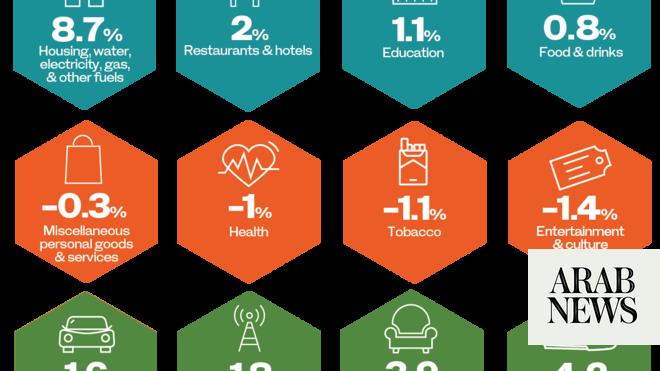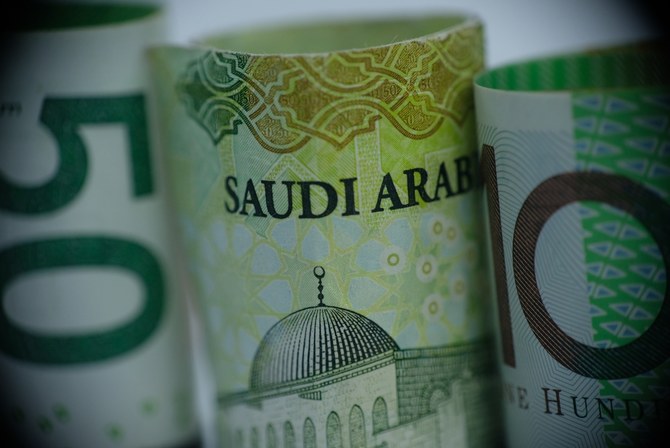
RIYADH: Saudi Arabia’s inflation remained steady at 1.6 percent in April for the second month in a row, driven by changes in housing prices.
The latest report from the General Authority for Statistics indicated that the Kingdom’s Consumer Price Index experienced a marginal increase of 0.3 percent in April compared to March.
The monthly inflation index was impacted by a 0.4 percent increase in the prices of housing, water, electricity, gas, and other fuels, which was primarily due to a 0.4 percent rise in actual housing rents and prices.
Additionally, the prices of personal goods and services increased by 1.2 percent. Similarly, food and beverage prices rose by 0.2 percent, clothing and footwear by 0.6 percent, and recreation and culture by 0.7 percent.
Conversely, prices in the furnishing and home equipment category declined by 0.5 percent, driven by a 0.5 percent decrease in the prices of furniture, carpets, and flooring.
However, the prices of services such as education, communications, health, and tobacco products did not show any significant change in April.
Annual inflation rises
However, on a yearly basis, the Kingdom’s CPI increased by 1.6 percent in April compared to the same period last year.
This rise is primarily attributed to a 9.4 percent increase in villa rents and a 0.8 percent rise in food and beverage prices.
Prices in restaurants and hotels also rose by 2 percent, driven by a 1.8 percent increase in food service prices. Meanwhile, the education sector witnessed a 1.1 percent increase, driven by a 4.1 percent rise in fees for intermediate and secondary education.
In contrast, prices for furnishings and home equipment decreased by 3.9 percent, influenced by a 6.0 percent decline in the prices of furniture, carpets, and flooring.
Similarly, prices in clothing and footwear decreased by 4.2 percent, influenced by a 6.6 percent decline in ready-made clothing prices. Transportation prices also decreased by 1.6 percent, affected by a 2.9 percent decrease in vehicle purchase prices.
According to GASTAT, rental prices were the main driver of inflation in April compared to the corresponding period in 2023.
“Actual housing rents increased by 10.4 percent in April 2024, influenced by the increase in villa rents by 9.4 percent. The increase in this category had a significant impact on maintaining the annual inflation rate for April 2024, given the weight this group represents (21.0 percent),” stated the GASTAT report.
Wholesale price index
In another report, GASTAT noted that Saudi Arabia’s wholesale price index rose by 3.4 percent in April compared to the same month in 2023.
This rise in the WPI was driven by a 14.5 percent increase in the prices of basic chemicals and a 12 percent jump in the prices of refined petroleum products.
In the fourth month of the year, prices for food products, beverages, tobacco, and textiles increased by 2.4 percent. This was primarily due to a 10.1 percent increase in the prices of leather, leather products, and footwear, and a 5 percent rise in the prices of grain mills, starch, and other food products.
Additionally, prices for agricultural and fishery products rose by 0.2 percent, driven by a 2.0 percent increase in prices for live animals and animal products.
Conversely, prices for ores and minerals dropped by 2.2 percent, largely due to a 2.2 percent decline in the prices of stone and sand.
Additionally, prices for metal products, machinery, and equipment fell by 0.6 percent. Significant decreases were observed in the prices of radio, television, and communication equipment by 6.7 percent, and office, accounting, and computing machinery by 2.7 percent.
The WPI decreased by 0.4 percent in April compared to March, primarily due to a 0.9 percent drop in the prices of other transportable goods, driven by an 8.0 percent decrease in the prices of basic chemicals.
Prices for agriculture and fishery products fell by 0.1 percent, influenced by a 0.4 percent decline in the prices of live animals and animal products. Ores and minerals saw a 0.1 percent decrease, mainly due to a 0.1 percent drop in the prices of stone and sand.
Conversely, prices for food products, beverages, tobacco, and textiles rose by 0.1 percent, due to a 0.2 percent increase in prices for meat, fish, fruit, vegetables, oils, and fats, along with a 0.1 percent rise in grain mills, starch, and other food product prices.
Additionally, prices for metal products, machinery, and equipment increased by 0.1 percent, driven by a 0.8 percent rise in the prices of basic metals.
Average prices up
In a separate analysis, GASTAT noted that in April, Abu Sorry Egyptian orange and Turkish plums saw the most significant upticks compared to the prior month, with increases of 18.09 percent and 12.82 percent, respectively.
Additionally, Pakistani mandarin and Lebanese grapes also experienced notable increases, rising by 9.11 percent and 5.88 percent, respectively.
Conversely, the goods and services showing substantial percentage drops in April, compared to March, were local and imported onions, experiencing decreases of 12.15 percent and 9.13 percent, respectively.
Additionally, local cucumbers and yellow apples also saw notable declines, with decreases of 6.35 percent and 5.40 percent, respectively.












